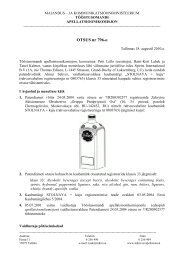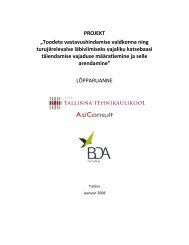Feasibility study for an Estonian Materials Technology Programme
Feasibility study for an Estonian Materials Technology Programme
Feasibility study for an Estonian Materials Technology Programme
Create successful ePaper yourself
Turn your PDF publications into a flip-book with our unique Google optimized e-Paper software.
78<br />
<strong>Feasibility</strong> <strong>study</strong> <strong>for</strong> <strong>an</strong> Estoni<strong>an</strong> <strong>Materials</strong> <strong>Technology</strong> <strong>Programme</strong><br />
4. Conclusions <strong>an</strong>d recommendations<br />
There are also other interesting initiatives <strong>for</strong> technology tr<strong>an</strong>sfer in Estonia<br />
Both Tallinn University of <strong>Technology</strong> <strong>an</strong>d University of Tartu have hired/are hiring technology tr<strong>an</strong>sfer<br />
experts<br />
Estoni<strong>an</strong> N<strong>an</strong>otechnology Competence Centre is <strong>an</strong> import<strong>an</strong>t initiative <strong>for</strong> tr<strong>an</strong>sferring n<strong>an</strong>otechnology<br />
results to comp<strong>an</strong>ies, the results remain to be seen<br />
In this case typically the comp<strong>an</strong>ies expect result tr<strong>an</strong>sfer in 2-3years time.<br />
Universities are currently key players in applied research, their role needs to be clarified in order to get<br />
comp<strong>an</strong>ies more interested in collaboration<br />
A single patent is almost never enough <strong>for</strong> successful technology tr<strong>an</strong>sfer, larger patent families<br />
around a specific technology are needed (University of Tartu, Institute of <strong>Technology</strong> is following<br />
this kind of model!)<br />
There are very few good examples of successful technology tr<strong>an</strong>sfer in the world, why would<br />
Estonia make a difference?<br />
Moreover, technology tr<strong>an</strong>sfer is seldom possible without incentives from the public sector<br />
Universities should be more attractive partners to private comp<strong>an</strong>ies, there is much more<br />
value to the economy with a technology being commercialised by <strong>an</strong> Estoni<strong>an</strong> comp<strong>an</strong>y<br />
th<strong>an</strong> with a single patent sold abroad<br />
Funding <strong>for</strong> research needs to be reorg<strong>an</strong>ised / reconsidered<br />
Fundamental research funding is easier to get th<strong>an</strong> funding <strong>for</strong> applied research<br />
EAS funding should be made less bureaucratic<br />
Universities are measured by number of publications, which is a bad measure <strong>for</strong> true applied research<br />
Funding instruments should <strong>for</strong>ce universities to involve comp<strong>an</strong>ies in projects<br />
Applied research c<strong>an</strong> also be done in comp<strong>an</strong>ies.<br />
High-tech comp<strong>an</strong>ies that have entered markets should be encouraged to continue research<br />
During the last 2 years, there have been too m<strong>an</strong>y gr<strong>an</strong>ts to comp<strong>an</strong>ies<br />
According to the director of the Enterprise Capability Division at EAS, comp<strong>an</strong>ies have applied<br />
<strong>an</strong>d received the gr<strong>an</strong>ts but could not use all the money<br />
Equipment<br />
In certain areas the university laboratories have state-of-the-art equipment that could be used by the<br />
industry as well.<br />
More personnel to operate this equipment are needed.<br />
Universities should offer the use of equipment time more frequently to comp<strong>an</strong>ies.<br />
Fundamental research<br />
Fundamental research is the basis <strong>for</strong> all adv<strong>an</strong>ced materials technologies <strong>an</strong>d very import<strong>an</strong>t <strong>for</strong> all<br />
future development<br />
There are internationally strong areas of research in Estonia in some areas of fundamental physics, chemistry<br />
<strong>an</strong>d materials<br />
The huge number of different areas of research me<strong>an</strong>s that it is very difficult to create world class technology<br />
in several areas<br />
A small country should carefully think of focus areas where it is putting its ef<strong>for</strong>ts in order to provide<br />
industrially applicable findings, either <strong>for</strong> local industry or <strong>for</strong> international technology tr<strong>an</strong>sfer<br />
The country should define a national strategy <strong>an</strong>d roadmap <strong>for</strong> future focus areas in materials technology<br />
based on strong areas of research <strong>an</strong>d potential synergies in the university research (coatings<br />
technology is a good example)<br />
Moreover, universities <strong>an</strong>d even research groups should have a concrete strategy on<br />
where to develop their expertise<br />
Currently the problem of ch<strong>an</strong>ging their research themes according to open calls <strong>an</strong>d programmes.<br />
This needs to be done in close collaboration with the industry to make the gap between technology<br />
development <strong>an</strong>d market needs narrower





